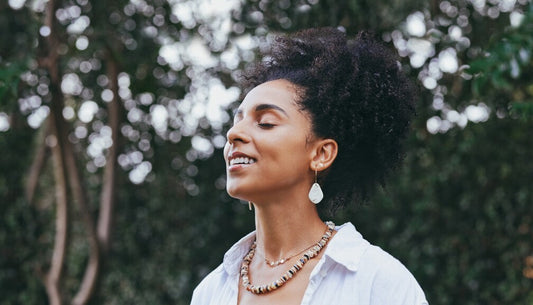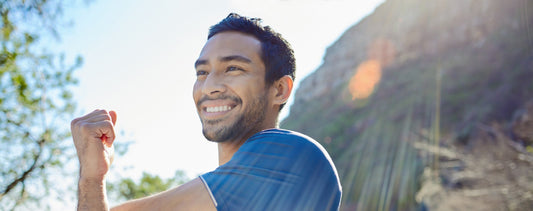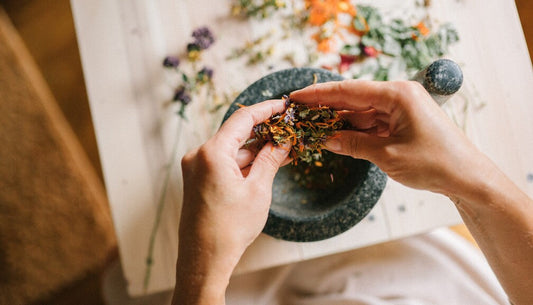Ghee comes from the Sanskrit word meaning “sprinkled,” which means that the milk fat is rendered from the butter to separate the milk solids and water. It’s essentially a form of clarified butter.
In Ayurveda, it’s been lauded as an essential superfood with dozens of health benefits for thousands of years. Here’s why:
Place butter in the pot. Bring the butter to a boil, then reduce the heat to a slow, steady simmer. The butter will begin to produce foam. Don’t remove this foam. It will begin to be absorbed into the butter, and you will hear the crackling sound of moisture and liquid being evaporated.
Let the butter simmer for up to 1 hour. Keep an eye on it and keep the flame on your stove as low as possible. The ghee is done when you see browned butterfat caramelized on the bottom of the pan and the top portion of the ghee is clear.
Cool down slightly and strain the ghee through a piece of cheesecloth to remove all the caramelized and browned butterfat. You can also use the same recipe to make ghee in a slow cooker without having to worry about it burning. It works well and takes 6 hours on low heat.
Place the ghee in jars and store. Ghee can be stored at room temperature for about one month or in the refrigerator for up to three months.
*Editor’s Note: The information in this article is intended for your educational use only; does not necessarily reflect the opinions of the Chopra Center's Mind-Body Medical Group; and is not a substitute for professional medical advice, diagnosis, or treatment. Always seek the advice of your physician or other qualified health providers with any questions you may have regarding a medical condition and before undertaking any diet, supplement, fitness, or other health program.
In Ayurveda, it’s been lauded as an essential superfood with dozens of health benefits for thousands of years. Here’s why:
- It promotes a healthy digestive tract: Healing your gut is an important first step in combating any digestive issues—and many other health concerns. Ghee is rich in butyric acid, a short-chain fatty acid that nourishes and repairs intestinal cells.
- It decreases inflammation and reduces risk of cancer: Butyric acid supports the production of killer T cells, which kill cancer cells. Ayurvedic physicians have used ghee for centuries to decrease inflammation.
- It can help reduce risk of heart disease: Ghee is rich on conjugated linoleic acid (CLA), a fatty acid known to protect against carcinogens, artery plaque, and diabetes. Because of these benefits, researchers say ghee can help prevent cardiovascular diseases.
- It may be able to help you lose weight: In addition to the cardiovascular benefits provided by the CLA in ghee, it has also been shown to help prevent weight gain and aid in weight loss. One study showed that participants who took CLA supplements over a six-month period lost significant amounts of weight.
- It helps cleanse negative emotional toxins and promotes positivity: Ghee is considered one of the most Sattvic foods, which are essential, energy-giving, and pure in nature. Sattvic foods promote positivity, growth, and expansion of consciousness.
How to Use Ghee
Ghee is a versatile fat and can be used in place of butter and other fats in a variety of culinary and non-culinary ways. These are a handful of examples:- Use it instead of regular butter for sautéing. Because it has a high-smoke point—485 degrees Fahrenheit—it won’t burn easily.
- Add it to dairy-free recipes. The milk solids are removed from ghee during the clarification process so most people who are lactose intolerant won’t have issues with ghee.
- Drizzle it over popcorn, pancakes, waffles, fish, poultry, and vegetables.
- Stir it into rice, quinoa, buckwheat, couscous, oatmeal, or millet.
- Massage it into skin instead of lotion or massage oils to keep your skin and joints supple.
- Moisturize your lips with it instead of lip balm.
- Rub ghee into your cuticles to help keep your nails healthy.
How to Make Ghee
What You Will Need:- Heavy bottomed stainless steel pot
- Strainer and flour sack kitchen towel (or a piece of cheesecloth)
- Clear glass container with tight-fitting lid
- 1 pound organic, unsalted butter
Place butter in the pot. Bring the butter to a boil, then reduce the heat to a slow, steady simmer. The butter will begin to produce foam. Don’t remove this foam. It will begin to be absorbed into the butter, and you will hear the crackling sound of moisture and liquid being evaporated.
Let the butter simmer for up to 1 hour. Keep an eye on it and keep the flame on your stove as low as possible. The ghee is done when you see browned butterfat caramelized on the bottom of the pan and the top portion of the ghee is clear.
Cool down slightly and strain the ghee through a piece of cheesecloth to remove all the caramelized and browned butterfat. You can also use the same recipe to make ghee in a slow cooker without having to worry about it burning. It works well and takes 6 hours on low heat.
Place the ghee in jars and store. Ghee can be stored at room temperature for about one month or in the refrigerator for up to three months.
*Editor’s Note: The information in this article is intended for your educational use only; does not necessarily reflect the opinions of the Chopra Center's Mind-Body Medical Group; and is not a substitute for professional medical advice, diagnosis, or treatment. Always seek the advice of your physician or other qualified health providers with any questions you may have regarding a medical condition and before undertaking any diet, supplement, fitness, or other health program.






















